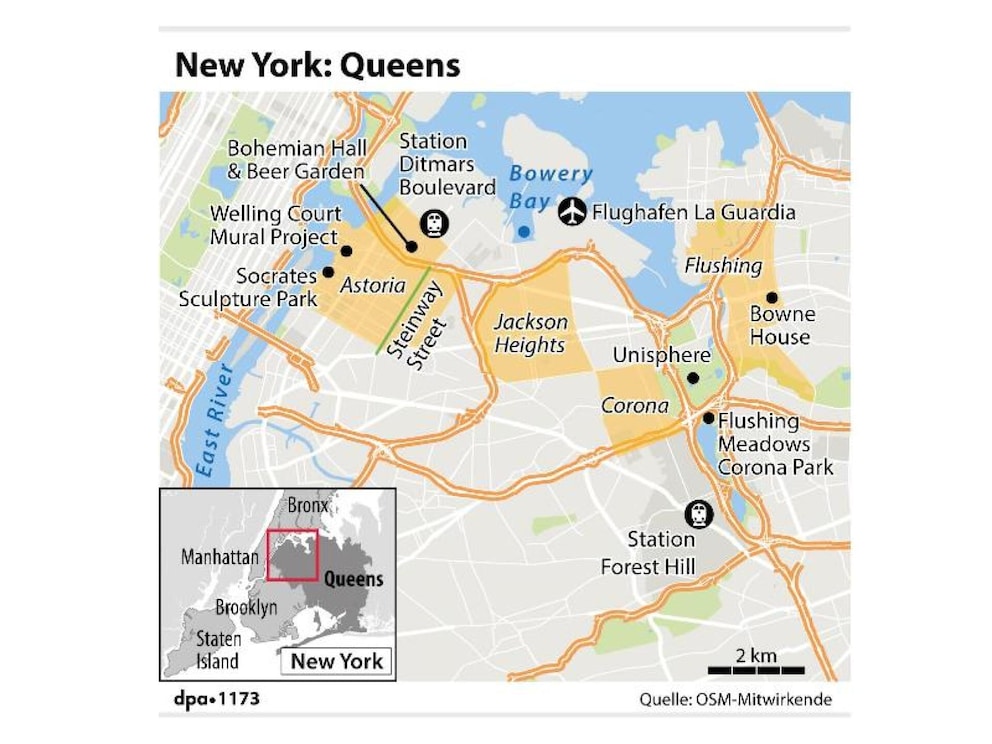Art, cuisine, history and 800 spoken languages: It doesn’t get more multicultural than in Queens. A tour of New York’s largest borough with someone who calls it home.
As the yogis slide into “downward-facing dog” and gaze headlong over the East River, their reward is the Manhattan skyline. The skyscrapers of the Upper East Side then seem to hang in the sky.
—
As a visitor, too, it’s refreshing to change your perspective and focus on something even more unknown: the New Yorker Borough Queens.
At weekends, free yoga classes lure you into the Socrates Sculpture Park in Astoria, the borough in the northwest corner of Queens. Midtown Manhattan, with its noise, bustle and streets clogged with yellow cabs, seems like a world far away. And something else is missing: the flood of tourists.
Queens is huge and diverse
After Manhattan, the Bronx, Staten Island and Brooklyn, Queens is the largest borough in New York with around 280 square kilometers. Around 2.3 million people live here. It is more than twenty kilometers as the crow flies from La Guardia Airport in the north to the surfers on wild Rockaway Beach in the south. What is the best way to understand the ethnically diverse Queens and its quarters?
Lori Lustig is the right address. The 64-year-old New Yorker is one of more than 300 Big Apple Greeters, ambassadors of the city who regularly accompany tourists on a voluntary basis. Lori grew up in Flushing, the destination of today’s West-East foray.
—

Queens is pure multiculturalism
First, it is relaxed along the East River. Then Lori turns onto a street full of street art. Colourful, flashy works of art are emblazoned on countless house walls, walls and garage doors. Welling Court Mural Project is the name of the place. Sprayers have been creative in the open-air art museum that stretches across several streets for ten years. Hours could be spent in this place alone.
Today, half of the people in Queens were born in another country, says Lori. “I’m in the other half.” Her grandparents immigrated from a region in what is now Ukraine. Her husband is from Belarus. The surname “Lustik” became “Lustig”. Therefore, Lori is often mistaken for German. The retired teacher works three days a week at a school in Astoria. Retirement was too boring for her.
“When children are new to school, they can choose from 162 languages on a form to indicate their mother tongue,” says Lori. According to the Endangered Language Alliance, 800 languages are spoken in Queens, more than anywhere else in the world.
—

The city that sleeps
In Queens you can see that New York, with its sea of lights at night, is a city that, contrary to the saying, sometimes sleeps. In quiet streets, residents are even woken up by the chirping of birds. It gets more colorful and lively the closer you get to Ditmars Boulevard station. Blue domes flash: a Greek Orthodox Church. A taste of the multitude of temples, mosques, churches and synagogues in the Flushing district.
Time for a breather. The choice falls on the Bohemian Hall & Beer Garden. It is considered the oldest beer garden in New York. The restaurant dates back to Bohemian immigrants, so pierogi, goulash and Jägerschnitzel are on the menu.

How the Steinway family came to Queens
A wave of German immigrants also ended up in the melting pot of Astoria, which at the time was still a rural suburb but one that promised work. More and more entrepreneurs bought farmland here. One of them was the legendary grand and upright piano maker Steinway. The family came under the name Steinweg. Son William Steinway had a new factory built in 1870 – and a whole Steinway Village for the around 400 employees, including a school, post office, kindergarten and recreation park. To this day, grand and upright pianos are made at Bowery Bay in Astoria.
—
Steinway Street runs three kilometers south through Astoria to the metro station of the same name. M Line trains travel east to Forest Hill terminus. “We have to go to line 7, though,” says Lori. “This is going to be cozy.”

To Asian-influenced Queens
The subway rattles through Little India and Little Bangladesh in Jackson Heights, then through Latin American-influenced Corona, before completely discharging at its eastern terminus in Flushing. Anyone who is spat out of the escalator imagines they are on another continent: colorful Chinese or Korean characters are emblazoned on the facades of the houses. The last census in 2010 showed that around 70 percent of the people in Flushing are from Asia. Ascending trend. In Chinatown, dried sea cucumbers, black chicken, snails, clams and other seafood are sold as delicacies – dead or alive.

A house with a great history
Walking distance to Flushing Main Street stands with the historic Bowne House an important monument to religious tolerance. The Briton John Bowne built the house in 1661. Because Bowne held regular Quaker meetings here, he was arrested in 1662 by the then governor. But Bowne successfully fought back and set a precedent for freedom of religion.
Flushing’s landmark, the Unisphere, which is over 40 meters high, couldn’t fit better. The steel globe in Flushing Meadows Park, built for the 1964 World’s Fair, is a reminder of the diversity and cosmopolitanism in Queens. Only a much smaller, yellow ball competes with the Unisphere each summer when neighboring Arthur Ashe Stadium fills up for the US Open tennis tournament. The spectators come from all over the world, of course.
—

–


